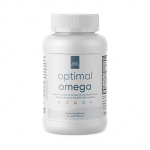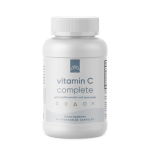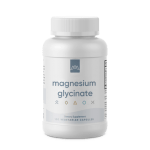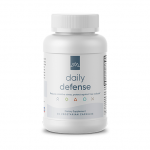Health Differences and Gender: What’s the Difference?
Skip to:
- Female and Male Nutrition: The Macro- and Micro-nutrients
- Nutrient Requirements
- Thyroid Problems
- Osteoporosis
- Heart Disease
- Depression
- Nutrient Support for Men and Women
While we’re very much alike in many ways, a few key differences separate the physiology of men and women.
Take hormones: While we all need testosterone and estrogen, men require more of the former and women the latter hormone for optimal health. Scientists even point out different ways in how the male and female brains work. [1]
Understanding these and other differences can help researchers prevent or treat diseases while providing optimal care for men and women. Take the fatty acid alpha-linolenic acid (ALA) in flaxseed in flaxseed oil.
For women, it’s a healthful fat. But for men, 4 studies find a link between ALA and prostate cancer. [2] Researchers recommend that men get omega-3 fatty acids from fish and vegetable fats mostly from olive oil.
That said, overall men and women share very similar nutritional needs.
Female & Male Nutrition: The Macro- and Micro-nutrients
The primary factors that determine caloric requirements are body size and physical activity levels. In other words, if you’re tall, muscular, and/or have a larger body frame, you’ll require more calories regardless of whether you’re a man or woman.
That same approach goes for protein, carbohydrates, and (for the most part) dietary fat. [3] To stay healthy, both genders require quality protein sources, nutrient-dense carbohydrates, and healthy dietary fat with a particular focus on the omega-3 fatty acids eicosapentaenoic acid (EPA) and docosahexaenoic acid (DHA).
Where gender differences in nutrition become more clear is with micronutrients:
- Calcium. For women, a higher-calcium diet can support bone health and prevent osteoporosis. Even so, calcium works as a team with other nutrients including magnesium. For men, too much calcium could contribute to prostate cancer. (Researchers argue vitamin D could offset this potential damage.)
- Iron. Pre-menopausal women lose iron during their menstrual period every month, which explains why the Recommended Daily Allowance (RDA) is higher for premenopausal women (18 mg a day) than for men (8 mg). Everyone — men and women — should avoid excess iron, which can trigger dangerous free radicals. [4] [5]
- Selenium. Some research suggests this mineral could reduce the risk for prostate cancer, leading some experts to recommend 200 micrograms a day for men (about 4 times above the RDA). [6]
Nutrient Requirements
Women and men also require different nutrients at different times of their lives.
“Nutrient requirements change as we get older, in large part because of changing hormone levels,” says Leslie Beck about optimal health for males and females. “Tailoring food intake to match nutritional needs is important to maintain immune function, prevent bone and muscle loss, preserve eyesight and protect our cells from free-radical damage.” [7]
Beck notes that in our 30s, our magnesium requirements increase to maintain strong bones. In our 40s, we want to increase our antioxidant intake from nutrients like vitamin C to prevent the oxidative stress that contributes to disease.
Additionally, females have specific nutrient needs during pregnancy and other important life changes. Women have a higher risk for osteoporosis during menopause, for instance, which increases the demand for certain nutrients like calcium and vitamin D. [8]
Specific conditions also impact women differently than men. These 4 conditions can impact anyone, and dismissing them as “primarily a problem for women” or “mostly a guy’s disease” can jeopardize everyone’s health and even become deadly.
That said, these conditions impact men and women differently.
Please discuss with your healthcare practitioner about specific strategies to address your unique health conditions or concerns.
Thyroid Problems
Your thyroid is a tiny, butterfly-shaped gland. But that tiny gland is also mighty: Your thyroid produces hormones that regulate numerous roles in your body including your metabolism and energy levels. [9]
In fact, thyroid hormones impact every cell, tissue, and organ.
Trouble results when your thyroid produces too much or too little of these hormones:
- Hypothyroidism occurs when your thyroid gland doesn’t produce enough thyroid hormones. Extreme fatigue, depression, and weight gain are among the symptoms of hypothyroidism.
- Hyperthyroidism occurs when your thyroid gland produces too many thyroid hormones. Irritability, nervousness, muscle weakness, unexplained weight loss, and sleep disturbances are among the symptoms of hyperthyroidism. [10]
Here’s the bad news for women: 1 in 8 will develop thyroid problems during their lifetime, and females are 5-8 times more likely than males to have thyroid problems. [11]
Among their issues, thyroid disease can create problems with your menstrual period, getting pregnant, and health problems for the mom and baby. [12] Likewise, a woman’s risk for thyroid disease (especially hypothyroidism) increases after menopause.
While thyroid problems primarily impact women, men aren’t off the hook. Thyroid disease involves many similar symptoms between genders, but a few are unique among men: Low sperm count, loss of muscle mass, and erectile dysfunction. [13]
If you suspect thyroid problems, talk with your healthcare practitioner about thyroid function tests including a full thyroid panel. [14]
Osteoporosis
The word means “porous bones”: Osteoporosis is a bone disease that occurs when your body loses too much or makes too little bone (or both). [15] Your bones become weak. A fall – or in more serious cases, a sneeze or minor bump – can cause those fragile bones to break.
Compared with men, women often have smaller, thinner bones. When estrogen levels drop during menopause, bone loss can occur (since estrogen protects your bone) and your chance for osteoporosis increases.
That helps explain why about 80% of the estimated 10 million Americans with osteoporosis are women. After age 50, about half of women will break a bone because of osteoporosis. [16]
But again, men are also at risk, especially as they age. After age 50, about 1 in 4 males can break a bone due to osteoporosis. [17]
If you’re at risk for osteoporosis, your physician might order a bone density scan and/or another testing to determine the best course of treatment. [18]
Heart Disease
“Why do men get more heart disease than women?”
That was the title of one study, which concluded that psychosocial and behavioral factors including smoking, alcohol, and coping with stressors put men at increased risk for heart disease. [19]
But heart disease provides an excellent example of why classifying a specific condition as “male” or “female” can lead to a lack of understanding or self-care for the supposedly less-at-risk gender.
For women, heart disease develops 7-10 years later. That doesn’t make it any less dangerous: Heart disease is still the major cause of death in women (especially after 65). [20]
The myth that females are somehow protected against heart disease can be deadly. In fact, heart attacks have increased over the past two decades for women in midlife (35 to 54 years), whereas that risk has decreased among similarly aged men. [21]
While men and women share the same risk factors for heart diseases, women have additional risk factors. According to Leslie Cho, MD, during pregnancy, these risk factors include:
- Endometriosis
- Polycystic ovary disease
- Diabetes
- High blood pressure [22]
Cho says women also experience unique symptoms of heart disease including:
- Fatigue
- Shortness of breath
- Pain in the neck, back, or jaw
- Other subtler symptoms 3-4 weeks before a heart attack occur [23]
Menopause, characterized by metabolic changes, like weight gain, can especially increase a woman’s risk for heart problems. Overall, heart attacks are harder on women than men. Females often require longer hospital stays and are more likely to die before leaving the hospital.
Your healthcare practitioner can determine your risk for heart disease and incorporate appropriate strategies with a physical exam, blood work, x-rays, and other testing. [24]
Depression
Everyone feels blue sometimes. But when that debilitating feeling persists, jeopardizing your health and happiness, you should seek help for depression. [25]
When you factor in depression-related deaths because of suicide and stroke, depression has the 3rd-highest global burden of disease. [26] Researchers predict it could be the leading cause of disease burden by 2030. [27]
Women are nearly twice as likely as men to be diagnosed with depression, which can occur at any age including after pregnancy or during menopause. [28] Studies show starting at puberty, young females have the greatest risk for major depression and mental disorders. [29]
Why the disparity? Researchers find that men typically externalize symptoms as, say, anger or irritability, whereas, women are more likely to internalize them.
Biology plays a role here, but so do life circumstances and specific stressors. [30] Women sometimes juggle too many tasks, feel unequal in their workspace, and worry about financial concerns.
Depression can manifest as many symptoms, including sadness or other unpleasant feelings, not enjoying something you once did, fatigue, and disturbed sleep patterns. [31]
A large number of men also suffer from depression, yet research shows they are less likely to recognize, talk about, and seek treatment. [32] Because many males express depression as anger or aggression, people around them might not be aware that the problem exists.
Depression comes in different forms. [33] If you suspect you are experiencing symptoms of depression, please do not dismiss them, contact your healthcare practitioner who can direct you to the right professional help to address your depression.
Nutrient Support for Men and Women
Certain conditions impact one gender more than another. Likewise, women require slightly different nutrient needs based on specific life events including menopause. For the most part, however, men and women have very similar nutrient needs.
Tailoring an optimal plan for your condition starts with your diet. Depending on your condition, our Core or Advanced plan provides all the nutrients you need to stay lean, healthy, and feel your best at any age.
Eating optimal amounts of healthy fats, protein, and nutrient-dense carbohydrates become the perfect strategy for any age and gender. Beyond that, work with your healthcare practitioner with the strategies below to tailor a plan that works specifically for your needs:
- Take a targeted multivitamin. Men and women require certain amounts of specific nutrients. A good multivitamin and mineral complex will account for those requirements while incorporating additional gender-specific nutrients. Our women’s multivitamin contains nutrients like green tea extract and curcumin that target breast health, for instance, whereas our men’s multivitamin contains nutrients that support prostate health.
- Start with the basics. Numerous obstacles – including poor topsoil lower in vitamins and minerals – means we don’t always get the optimal amounts of the nutrients we require from food. [34] Beyond a multivitamin, everyone should incorporate a few foundational supplements that cover those nutrient bases:
- Vitamin D3 + Probiotics — among its benefits, vitamin D helps support hormonal balance, whereas probiotics help optimize gut health. [35] [36]
-
- Optimal Omega — chronic inflammation is a big driver for nearly every disease. [37] Omega-3 fatty acids help reduce inflammation and offer many other health benefits including improved lipid levels. [38]
-
- Vitamin C — this multitasking water-soluble vitamin protects against immune system deficiencies, heart disease, prenatal health problems, skin wrinkling, and so much more. [39]
-
- Magnesium Glycinate — most of us don’t get enough of this mineral that plays a part in over 300 enzyme systems, making supplementation essential. Magnesium is very calming, so taking it before bedtime can help you fall and stay asleep.
The MaxLiving Daily Essentials is a great start to proper nutrition: all of your essential nutrients conveniently packed in daily packets.
Consult with your healthcare practitioner to determine other foundational supplements suitable for your unique health status.
Address specific nutrient requirements. Targeted nutrients can address specific gender-related concerns, including low libido and menopausal systems. But they can also address conditions including:
- Sleep — if you have trouble falling or staying asleep, consider a supplement to help optimize sleep levels.

- Stress — once you have diet and lifestyle factors dialed in, a few supplements can help you better manage stress levels. Chronic stress depletes B vitamins, for instance, so using a B Complex (with Delayed-Release) can help replenish those levels.
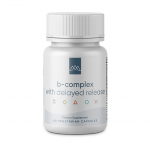
- Immune support — if you’re prone to getting sick during cold and flu season, consider the immune-supporting formula Daily Defense.
Biochemical individuality underlies nutrition and vibrant health. That’s a fancy term to say everyone is different. You are unique, and so are your nutritional needs.
Working with a healthcare practitioner can help individualize a program just for you, address specific gender- or age-related concerns, and maintain health and wellbeing at any age.
Just because statistically women or men have higher risks for specific health conditions doesn’t mean you need to accept these as your fates. You have tremendous control over your health with the everyday choices you make starting with what you put on the end of your fork.
Discuss including these and/or any other additional supplements with your healthcare practitioner. Never modify any medications or other medical advice without your healthcare practitioner’s consent.
References
- https://stanmed.stanford.edu/2017spring/how-mens-and-womens-brains-are-different.html
- https://www.health.harvard.edu/newsletter_article/good-nutrition-should-guidelines-differ-for-men-and-women
- https://www.health.harvard.edu/newsletter_article/good-nutrition-should-guidelines-differ-for-men-and-women
- https://www.sharecare.com/health/vitamins-supplements/a-good-multivitamin-without-iron
- http://www.irondisorders.org/iron-tiggers-free-radical-activity
- https://www.health.harvard.edu/newsletter_article/good-nutrition-should-guidelines-differ-for-men-and-women
- https://www.theglobeandmail.com/life/health-and-fitness/health/nutrition-by-age-a-guide-to-eating-healthfully-and-meeting-daily-needs/article23360909/
- https://www.theloop.ca/why-women-have-completely-different-nutritional-needs-than-men/
- https://www.thyroid.org/media-main/press-room/
- https://www.thyroid.org/media-main/press-room/
- https://www.thyroid.org/media-main/press-room/
- https://www.womenshealth.gov/a-z-topics/thyroid-disease
- https://www.verywellhealth.com/thyroid-disease-in-men-3886166
- https://www.thyroid.org/thyroid-function-tests/
- https://www.nof.org/patients/what-is-osteoporosis/
- https://www.nof.org/preventing-fractures/general-facts/what-women-need-to-know/
- https://www.nof.org/patients/what-is-osteoporosis/
- https://www.radiologyinfo.org/en/info.cfm?pg=osteoporosis
- https://www.ncbi.nlm.nih.gov/pubmed/10863872
- https://www.ncbi.nlm.nih.gov/pmc/articles/PMC3018605/
- https://www.ncbi.nlm.nih.gov/pmc/articles/PMC3018605/
- https://health.clevelandclinic.org/women-men-higher-risk-heart-attack/
- https://health.clevelandclinic.org/women-men-higher-risk-heart-attack/
- https://www.mayoclinic.org/diseases-conditions/heart-disease/diagnosis-treatment/drc-20353124
- https://www.webmd.com/depression/guide/detecting-depression#1
- https://www.ncbi.nlm.nih.gov/pubmed/24694747
- https://www.ncbi.nlm.nih.gov/pmc/articles/PMC4478054/
- https://www.mayoclinic.org/diseases-conditions/depression/in-depth/depression/art-20047725
- https://www.ncbi.nlm.nih.gov/pmc/articles/PMC4478054/
- https://www.mayoclinic.org/diseases-conditions/depression/in-depth/depression/art-20047725
- https://www.mayoclinic.org/diseases-conditions/depression/in-depth/depression/art-20047725
- https://www.nimh.nih.gov/health/publications/men-and-depression/index.shtml
- https://www.webmd.com/depression/guide/depression-types#1
- https://www.scientificamerican.com/article/soil-depletion-and-nutrition-loss/
- https://www.ncbi.nlm.nih.gov/pubmed/18689389
- https://www.ncbi.nlm.nih.gov/pmc/articles/PMC5964481/
- https://www.ncbi.nlm.nih.gov/pmc/articles/PMC3492709/
- https://nccih.nih.gov/health/omega3/introduction.htm
- https://www.webmd.com/diet/features/the-benefits-of-vitamin-c#1

